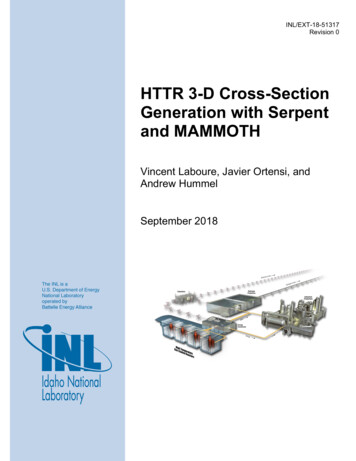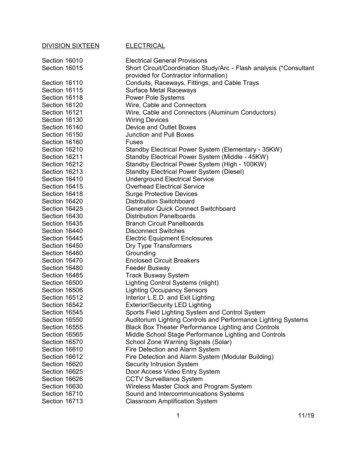
Transcription
INL/EXT-18-51317Revision 0HTTR 3-D Cross-SectionGeneration with Serpentand MAMMOTHVincent Laboure, Javier Ortensi, andAndrew HummelSeptember 2018
DISCLAIMERThis information was prepared as an account of work sponsored by anagency of the U.S. Government. Neither the U.S. Government nor anyagency thereof, nor any of their employees, makes any warranty, expressedor implied, or assumes any legal liability or responsibility for the accuracy,completeness, or usefulness, of any information, apparatus, product, orprocess disclosed, or represents that its use would not infringe privatelyowned rights. References herein to any specific commercial product,process, or service by trade name, trade mark, manufacturer, or otherwise,does not necessarily constitute or imply its endorsement, recommendation,or favoring by the U.S. Government or any agency thereof. The views andopinions of authors expressed herein do not necessarily state or reflectthose of the U.S. Government or any agency thereof.
INL/EXT-18-51317Revision 0HTTR 3-D Cross-Section Generation with Serpent andMAMMOTHVincent Laboure, Javier Ortensi, and Andrew HummelSeptember 2018Idaho National LaboratoryINL ART ProgramIdaho Falls, Idaho 83415http://www.inl.govPrepared for theU.S. Department of EnergyOffice of Nuclear EnergyUnder DOE Idaho Operations OfficeContract DE-AC07-05ID14517
INL ART ProgramHTTR 3-D Cross-Section Generation with Serpent andMAMMOTHINL/EXT-18-51317Revision 0September 2018
REVISION LOGRev.DateAffected Pages009/19/2018AllRevision DescriptionNew document
ABSTRACTThe High Temperature Test Reactor (HTTR) is a graphite-moderated thermalreactor with a nominal power output of 30 MWth. The purpose of this work is toprepare a set of neutron cross sections for use in the transient analyses of threeLoss of Forced Cooling (LOFC) events planned for this reactor. The crosssections are generated with the Serpent 2 3-D Monte Carlo code to include theaxial heterogeneity and the strong axial coupling of this core. The approachyields good agreement of results when compared to previously used 2-D latticemodels, which require a fine spatial discretization and, surprisingly, comes at ahigher computational cost. In addition, the temperature distribution must beconsidered to obtain reasonable cross sections and the axial leakage componentdominates the spectral effects in the core. Consequently, a temperature model asa function of the fuel and moderator temperatures is adopted, and the core isdepleted to 390 effective full-power days (EFPDs). A full tabulation of crosssections is prepared at this burnup point for a variety of fuel and moderatortemperatures. Next, the multiphysics reactor application MAMMOTH is used toevaluate the quality of these cross sections using a diffusion solver. As expected,the homogenization error in the cross sections is significant and the SuperHomogenization (SPH) correction from MAMMOTH is necessary to preservekey reaction rates. The SPH-corrected MAMMOTH results are in excellentagreement with the Serpent results and reproduce both the reference powerprofile and temperature coefficients at each tabulation point. This fact confirmsthe accuracy of the SPH-corrected cross sections and demonstrates the maturityof using Serpent 2 and MAMMOTH for 3-D cross-section generation, even forreactors as complex as the HTTR. Finally, the authors recommend that the crosssections should be parametrized with the local burnup and that a full core burnupcalculation with coupled thermal-fluids would provide a better estimate of theinitial condition for any subsequent transient analysis. Unfortunately, this was notwithin the scope of this work, and direct analysis with these tabulations should beconsidered as a first-order approximation, at best.vii
viii
CONTENTSABSTRACT. viiACRONYMS . xi1.INTRODUCTION . 122.MODEL DESCRIPTION AND VERIFICATION . 132.1 Model Comparison . 132.2 Model Overview and Methodology . 163.3-D CROSS-SECTION GENERATION . 183.1 Energy Structure . 183.2 Temperature Influence on the Core. 193.3 Temperature Model . 193.4 State Points. 213.5 Poison Densities and Cross Sections. 224.MAMMOTH SPH CORRECTION. 234.1 Eigenvalue and Temperature Coefficients . 234.2 Power Profile. 275.CONCLUSION . 296.REFERENCES . 29FIGURESFigure 1. Axial view of a standard HTTR fuel block with fuel (dark grey), He (blue), and BP(yellow). 14Figure 2. Four different HTTR fuel columns/stacks (fuel/BP wt.% enrichment). The axial slicesare indexed from 1 (top) to 9 (bottom). . 15Figure 3. HTTR core layout with fuel positions (Stacks 1–4), control rods (C, R1, R2, R3),replaceable reflectors (RR), and instrumentation (I). . 15Figure 4. Supercell arrangement with central CR column surrounded by six fuel columns. . 16Figure 5. Average temperature evolution for the 9-MW LOFC from [23]. . 20Figure 6. Example of the few-point approximated temperature profiles used in Serpent 2 for fueland moderator average temperatures of 900 K and 600 K, respectively. The slice indexgoes from 1 (top) to 9 (bottom). . 21TABLESTable 1. MCNP6.1 and Serpent 2 eigenvalue comparisons using ENDF/B-VII.0 (293 K). 14ix
Table 2. Main HTTR design specifications. . 16Table 3. Main HTTR fuel specifications. . 17Table 4. Burnup steps chosen the depletion calculation in days and MWd/kgU with the reactoroperating at 30 MW. . 18Table 5. Energy bounds in eV of the ten energy groups of index g. . 19Table 6. Temperature table points selected for the cross-section functionalization in K for the 30MW transient. Each temperature corresponds to the average; is thus notnecessarily not physical. . 22Table 7. Temperature table points selected for the cross-section functionalization in K for the 9MW transient. . 22Table 9. MAMMOTH eigenvalues obtained with and without SPH correction compared toSerpent 2 for the 9-MW case. . 24Table 10. Moderator temperature coefficients in/ from MAMMOTH with and withoutSPH correction compared to Serpent 2 for the 30-MW case. . 25Table 11. Moderator temperature coefficients in/ from MAMMOTH with and withoutSPH correction compared to Serpent 2 for the 9-MW case. . 26Table 12. Fuel temperature coefficients in/ from MAMMOTH with and without SPHcorrection compared to Serpent 2 for the 30-MW case. . 26Table 13. Fuel temperature coefficients in/ from MAMMOTH with and without SPHcorrection compared to Serpent 2 for the 9-MW case. . 27Table 14. MAMMOTH error in power profile with and without SPH correction for the 30-MWcase. . 27Table 15. MAMMOTH error in power profile with and without SPH correction for the 9-MWcase. . 28x
ACRONYMSARTAdvanced Reactor TechnologiesBPburnable poisonBUburnupCRcontrol rodEFPDeffective full power dayeVelectron-voltHTGRHigh Temperature Gas ReactorHTTRHigh Temperature Test ReactorJAEAJapan Atomic Energy AgencyLOFCloss of forced coolingLWRLight Water ReactorMCNPMonte Carlo N-Particle Transport CodeMOOSEMultiphysics Object Oriented Simulation EnvironmentRMSroot mean squareRRreplaceable reflectorSPHsuper homogenizationTRISOtristructural isotropicUO2uranium dioxidexi
HTTR 3-D Cross-Section Generation with Serpent andMAMMOTH1.INTRODUCTIONThe High Temperature Engineering Test Reactor (HTTR) is a graphite-moderated, helium-cooledreactor developed by the Japan Atomic Energy Research Institute, now the Japan Atomic Energy Agency(JAEA). Built at the Oarai Research and Development Center, this advanced reactor first reachedcriticality in November 1998, followed by full-power operation on December 7, 2001 [1]. Designed andbuilt to further establish High Temperature Gas Reactor (HTGR) technologies, the core has been centralto many reactor physics experiments [2,3,4,5] and safety studies [6,7]. Additionally, the coreconfiguration and experiments have been extensively benchmarked [8,9,10]. Operated at a nominal poweroutput of 30 MWth, this one-of-a-kind reactor offers many advantages over the typical light water reactor(LWR). For instance, the tristructural isotropic (TRISO) fuel particles are developed to inherently retainall fission products, and the graphite core allows for much higher output temperatures. However, they alsoadd challenges in the numerical modeling of these systems. The doubly heterogeneous nature of theTRISO particles arising from the multiple coated layers ultimately leads to the need of special treatmentsfor the proper generation of cross sections with deterministic methods. In addition, the random nature ofthese particles can present further difficulties. Several codes, such as SCALE [11] and DRAGON [12],have successfully addressed this issue. Also, unlike LWRs that tend to have localized effects, the muchlarger neutron migration area in the HTTR leads to a highly coupled core. This makes the task ofincluding long-range spectral effects in lattice calculations particularly difficult. However, supercellcalculations have proven successful [13], although these tend to require large amounts of computationtime [14] to achieve respectable results when compared to 2-D Monte-Carlo calculations. Finally, the corehas a very high temperature gradient when operating at full power, thus essentially nullifying anyisothermal assumptions. In addition, the core is highly heterogeneous, even at the fuel block level. Severalkey findings from previous work [13] led to the conclusions that 3-D cross-section preparation is crucialto resolve the heterogeneity problems. Current improvements in the Serpent 2 [15] Monte-Carlo codeallow depletion calculations with a full-core configuration; therefore, a fully explicit HTTR model wasconstructed and depleted to 390 effective full-power days (EFPDs). The ENDF/B-VII.0 neutron crosssection libraries are used to perform comparisons to the Monte Carlo N-Particle Transport Code (MCNP)reference model while ENDF/B-VII.1 libraries are used in the depletion and the cross-section preparation.As part of a cooperative effort between Japan and the United States under the Civil Nuclear EnergyWorking Group, the Advanced Reactor Technologies (ART) Program at INL and JAEA are participatingin a multi-national research project sponsored by the Nuclear Energy Agency of the Organization ofEconomic Cooperation and Development. Three pressurized loss of forced cooling (LOFC) tests arebeing performed at the HTTR to confirm the ability of the core to shut down and safely reject heat in theevent of a circulator trip, without control rods being inserted. These events are classified as anticipatedtransients without scram. The first of the experiments was completed on December 21, 2010, at 9 MW(30% of rated power), with data provided by JAEA to participating countries (including the U.S.) to beused for system code/model validation. The LOFC#2 (30 MW) and LOFC#3 (9 MW with loss of VesselCooling System) experiments are tentatively scheduled to be completed in 2019. The present workfocuses on generating the cross-sections to be used in any multiphysics code that is able to compute amore accurate temperature profile than that originally included in the Serpent2 model.The current approach entails the computation of 3-D multigroup cross sections at various state pointsfor the variables that are deemed to have a significant impact on the cross section. This is followed by theapplication of the Super Homogenization (SPH) method [16,17] to correct the homogenized crosssections. This enables the undertaking of transient simulations such as the HTTR LOFC events. Twoxii
LOFC cases are primarily considered in the preparation of cross sections in this work: one starting at 9MW and another at 30 MW.This report is organized as follows: Section 2 describes and verifies the Serpent 2 3-D HTTR modelagainst the Monte-Carlo N-Particle (MCNP) [18] continuous energy code. Based on this model, a studyregarding the importance of the core temperature distribution is performed in Section 3 to determine howthe cross sections should be functionalized. It is noted that the functionalization is only done at 390EFPD, assuming a fixed temperature distribution during the entire depletion calculation. A more accurateapproach would be to also tabulate cross sections at each depletion step and to create a library dependingon temperature and the local burnup. This would then allow to repeat the depletion calculation using amore accurate temperature distribution. Although it is likely that this local burnup may also be ofsignificant importance, since the LOFC transient and the time to recriticality are highly dependent on theinitial xenon concentrations, which in turn depend on the local flux level [19], the cross sections are notconsidered to depend thereon in this report (mostly due to time constraint). The approximated temperatureprofile as well as the tabulation points are also described Section 3. At that point, the cross sections havebeen generated by Serpent2 with postprocessing steps being done by MAMMOTH [20], the generalreactor physics application based on the Multiphysics Object Oriented Simulation Environment(MOOSE) [21]. In Section 4, the homogenization error stemming from the cross section is evaluated,emphasizing the need for SPH correction. This is performed within MAMMOTH, whose SPH procedurerelies on the Preconditioned Jacobian-Free Newton-Krylov method [17]. Drastically improved results forboth the temperature coefficients and power profile compared to the uncorrected cross sections arepresented for both the 9-MW and 30-MW LOFC. Final conclusions and the identification of future workare discussed in Section 5.2.MODEL DESCRIPTION AND VERIFICATION2.1Model ComparisonThe Serpent 2 model is derived from the most recent criticality benchmark evaluation [10], whichuses MCNP. To compare equivalent models, both the MCNP (using v6.1.1) and Serpent 2 models aremodified accordingly to make them closer to reality (and as close to each other as possible):1. The MCNP benchmark model assumes a burnable poison (BP) pitch equal to the fuel pin pitch, whenthe BPs are actually offset. The pitch is appropriately calculated and changed in both models.2. Fuel handling holes are not modeled in the benchmark, but rather the graphite density is adjusted.Due to the complex geometry, a volume equivalent cylinder is instead added to all fuel blocks,removable reflectors, and control rod (CR) blocks in both models.3. The benchmark contains a graphite overcoat on the TRISO fuel, but the process of generating therandom particle distribution file in Serpent 2 does not permit adding this; therefore, it is removed.4. Unlike MCNP, Serpent 2 has the capability of randomly distributing the TRISO particles in the fuelpins, and all of the depletion analysis presented in this report use that feature. A homogenous mixtureof 7.9 wt.% UO2 and graphite matrix is used in all of the fuel pins to compare against the MCNPmodel.The eigenvalues are first compared at the fuel block level using specular boundary conditionseverywhere to verify geometry and axial material distributions. This is very important because neitherfuel nor BPs span the entire block length. Helium and graphite gaps are at the ends of the fuel, and the BPchannels are loaded with a 10-cm graphite zone splitting the BP in half as shown in Figure 1.13
Figure 1. Axial view of a standard HTTR fuel block with fuel (dark grey), He (blue), and BP (yellow).Table 1 lists the eigenvalues for the different cases, and excellent agreement is observed at the blocklevel. Next, the four different types of fuel columns or block stacks are examined. Each column consistsof nine blocks: two lower replaceable reflector (RR) blocks, five central fuel blocks, and two upper RRblocks. The lower and upper two fuel blocks for each stack are the same; these different stacks are shownin Figure 2 and a radial view of the core layout is shown in Figure 3. Again, there is an excellentagreement at the column level. The next check is to examine a supercell consisting of the central CRcolumn surrounded by six fuel columns as seen in Figure 4. Due to how boundary conditions can beapplied between the two codes, the supercell is placed into a helium-filled cylinder with specularboundary conditions and the results differ by only 10 pcm. Full core models are then compared with theCRs fully inserted, fully withdrawn, and at the cold critical condition heights [8] (note however that thecore is not critical in that latter case because of the homogeneous enrichment chosen for this code-to-codecomparison). The largest difference in the core eigenvalue is only 52 pcm and occurs with all rods fullyinserted. This difference is most likely a reflection of the different particle tracking methods employed inthe two codes, as Serpent 2 uses a combination of traditional surface-tracking and the Woodcockdelta-tracking methods. Ultimately, the models are in good agreement.Table 1. MCNP6.1 and Serpent 2 eigenvalue comparisons using ENDF/B-VII.0 (293 K).Models (homogenizedMCNP6.1Serpent 2Fuel block1.23597 0.000011.23591 0.00006Fuel columns1.23422 0.000031.23425 0.00006Supercell (rods in)1.13782 0.000031.13777 0.00006Supercell (rods out)1.34230 0.000031.34220 0.00004Full-core (rods in)0.86089 0.000020.86141 0.00006Full-core (rods out)1.22328 0.000021.22365 0.00004Full-core (critical)1.17790 0.000031.17754 0.0000414 pcm-6 3-5-10-52-3736
Stack 1Stack 2Stack 3Stack 4.8/2.0RRRRRRRRRRRRRRRRFigure 2. Four different HTTR fuel columns/stacks (fuel/BP wt.% enrichment). The axial slices areindexed from 1 (top) to 9 (bottom).Figure 3. HTTR core layout with fuel positions (Stacks 1–4), control rods (C, R1, R2, R3), replaceablereflectors (RR), and instrumentation (I).15
Figure 4. Supercell arrangement with central CR column surrounded by six fuel columns.2.2Model Overview and MethodologyTable 2 lists the main HTTR core design specifications and Table 3 gives an overview of the fuelform characteristics. There is a total of 12 different fuel enrichments in the 150 fuel blocks. Due to bothmemory and computational limitations, the core is depleted at the fuel block level. The depletion stepsand corresponding burnup (BU) limits are shown Table 4. The predictor-corrector method is used for thetime integration. A xenon equilibrium option was chosen to start.Table 2. Main HTTR design specifications.Thermal Power (MW)Outlet Coolant Temperature ( C)Inlet Coolant Temperature ( C)Primary Coolant Pressure (MPa)Core StructureEquivalent Core Diameter (m)Effective Core Height (m)Average Power Density (W/cm3)Fuel/EnrichmentFuel TypeBurn-Up Period (EFPDs)Coolant Material/FlowReflector Thickness: Top/Side/Bottom (m)Number of Fuel AssembliesNumber of Fuel ColumnsNumber of Control Rod Pairs: In Core/In Reflector1630850–9503954Graphite2.32.92.5UO2 / 3–10 wt.%Pin-in-Block660Helium Gas / Downward1.16/0.99/1.16150307/9
Table 3. Main HTTR fuel specifications.Fuel KernelMaterialUO2Diameter (µm)6003Density (g/cm )10.41Coated Fuel ParticleType/MaterialTRISODiameter (µm)920Impurity (ppm) 3 (Boron Equivalent)Fuel CompactTypeHollow CylinderMaterialCFPs, Binder, and GraphiteOuter/Inner Diameter (cm)2.6/1.0Length (cm)3.9Packing Fraction of CFPs (vol%)30a (A and B-3)35 (B-1 and B-2)3Density of Graphite Matrix (g/cm )1.7Impurity in Graphite Matrix (ppm) 1.2 (Boron Equivalent)Fuel RodOuter Diameter (cm)3.4Sleeve Thickness (mm)3.75Length (cm)54.6Number of Fuel Compacts14Number of Rods in a Block31/33Graphite SleeveTypeCylinderMaterialIG-110 GraphiteLength (cm)58Gap Width between Compact and Sleeve (mm) 0.25Graphite ialIG-110 GraphiteWidth across Flats (cm)36Height (cm)58Fuel Hole Diameter (cm)4.13Density (g/cm )1.75Impurity (ppm) 1 (Boron Equivalent)a. Only A-Type fuel with a packing fraction of 30 is used in this study.17
Table 4. Burnup steps chosen the depletion calculation in days and MWd/kgU with the reactor operatingat 30 MW.StepsBurnup (days)Burnup 107.0072608.67831010.34936012.011039013.01The position of the control rods C, R1, and R2 (see Figure 3) depends on the power of the core. Forthe 30-MW steady-state, they are 277.0 cm withdrawn. For 9 MW, the temperature of the core is lowerand less reactivity should be inserted for a critical core configuration, which is why the control rods areonly 227.2 cm withdrawn. On the other hand, the control rod C3 is only used for shutdown margin and isfully withdrawn in both cases (406.0 cm). In this report, the reactor is assumed to have been operated at30 MW for 390 EFPDs. The detailed power history of the HTTR core was not implemented in thedepletion sequence as it was not available. The steady-state starting points for two LOFC transients areconsidered: (1) one starting at 30 MW, and (2) another one starting at 9 MW, assuming that equilibriumfor I-135 and Xe-135 has been reached.3.3-D CROSS-SECTION GENERATIONIn this section, the functionalization of the cross section is presented. It is noted that it is only done at390 EFPD, assuming a fixed temperature distribution during the entire depletion calculation. A moreaccurate approach would be to also tabulate cross-sections at each depletion step and to create a librarydepending on temperature and the local burnup. This would then allow to repeat the depletion calculationusing a more accurate temperature distribution. Although it is likely that this local burnup would be ofsignificant importance – since the LOFC transient and the time to recriticality are highly dependent on theinitial xenon concentrations, which in turn depend on the local flux level [18], the cross-sections are notconsidered to depend thereon in this report (mostly due to time constraint). This constitutes anapproximation because a more sophisticated depletion and temperature model (e.g. through multiphysicscoupling) will result in different local burnups throughout the core and thus a different initial condition forthe subsequent transients.3.1Energy StructureThe energy structure chosen for the HTTR is one that was successfully used for the Transient ReactorTest Facility [22] with the fastest two energy groups combined to improve statistics. The energy boundsare summarized in Table 5. This structure is used for both the multigroup cross-section generation and todetermine the power profile from Serpent 2.18
Table 5. Energy bounds in eV of the ten energy groups of index g.gLowerUpper10981.00E-5 2.00E-2 4.73E-22.00E-2 4.73E-2 10E 048.10E 01.33E 231.33E 23.48E 323.48E 31.16E 511.16E 54.00E 7Temperature Influence on the CoreA preliminary study was performed to show that the influence on the multiplication factor of themoderator and fuel temperature radial distribution was not significant compared to that of their respectiveaxial distribution. For that reason, the cross-section library is generated for temperature profiles, whichonly have axial dependency.3.3Temperature ModelUsing an isothermal temperature model in the 3-D simulation yields significant discrepancies in thecross sections. This is not only because of the large axial temperature gradients in the core but alsobecause of its strong axial coupling. The general approach is to establish an approximate temperatureprofile to be used throughout the transient. Given average moderator and fuel temperatures, this profile isapplied to obtain local temperatures in each axial slice of the core and used to run the Serpent 2calculations. The interpolation of the cross-sections during the transient is also done using the localtemperatures. An assumption implied by this methodology is thus that the temperature distribution changeover time does not affect the cross sections tabulated at steady-state temperatures.More specifically, since Serpent 2 is not coupled to any other code to obtain an accurate temperatureprofile, it is necessary to make approximations. Besides, in an effort to minimize the computationalburden of each individual Serpent 2 calculation, it is found that limiting the number of distincttemperatures for both moderator and fuel is crucial. Therefore, it is essential to accurately (1) bound thefuel and moderator temperatures during the 9-MW and 30-MW LOFC transients to make sure thetemperature state points include all the temperatures encountered during the transient; and (2) predict theaxial temperature profile.To address the first point, the 9-MW transient shown in Figure 5 is considered. Several points clearlyappear that can be reasonably assumed to hold for the 30-MW case: the increase in fuel temperature afterLOFC is very limited, due to the strongly negative fuel temperature coefficient, and the moderatortemperature never exceeds the fuel temperature. These two properties are also assumed to be true at anyspatial location of the core.To address the second, the 9-MW and 30-MW steady-state temperature distributions from [23] areconsidered. Then the temperature profiles are determined as follows:1. The temperature shape is assumed to be time-independent throughout the transient. Although heatconduction and radiation tend to make the distribution flatter when no heat is generated, the decayheat distribution has a similar profile as the power since the fission product concentration is closelyrelated to the number of fissions having occurred there. Furthermore, the large graphite heat capacityimplies that heat diffusion is a relatively slow process. Since the shapes for the 9-MW and 30-MWsteady-state temperature distributions are fairly similar, the latter shape is selected for both cases.Note however, that while this is a good approximation for the fuel temperature, it is a little morequestionable for the moderator temperature since its gradient gets larger as the power increases. Thisdoes not constitute a limitation of the method but was mainly done because of time constraint.2. To minimize the number of distinct temperatures used in the Serpent 2 calculations that rapidlybecome expensive, slices with similar temperatures (using engineering judgement) are assigned totheir average. For the moderator, Slices 1 to 3 are then combined, Slice 4 is considered individually,19
and Slices 5 to 9 are grouped together (see Figure 2). For the fuel, Slice 3 is considered on its ownwhile Slices 4 to 7 are combined (Slices 1, 2, 8,
agreement with the Serpent results and reproduce both the reference power profile and temperature coefficients at each tabulation point. This fact confirms the accuracy of the SPH-corrected cross sections and demonstrates the maturity of using Serpent 2 and MAMMOTH for 3-D cross-sect










